The Search for the Portrait that Belonged to Kittel Pages at The Face Of Bach
The Queens College Lecture of March 21, 2001 - Page 10 - A Description of the Weydenhammer Portrait Fragment
The Face Of Bach
This remarkable photograph is not a computer generated composite; the original of the Weydenhammer Portrait Fragment, all that
remains of the portrait of Johann Sebastian Bach that belonged to his pupil Johann Christian Kittel, is resting gently on the surface
of the original of the 1748 Elias Gottlob Haussmann Portrait of Johann Sebastian Bach.
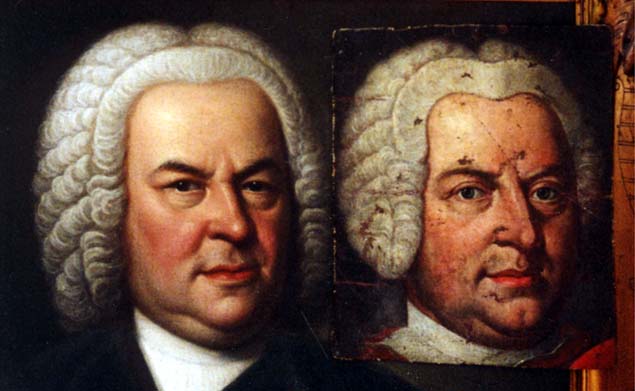
1748 Elias Gottlob Haussmann Portrait, Courtesy of William H. Scheide, Princeton, New Jersey
Weydenhammer Portrait Fragment, ca. 1733, Artist Unknown, Courtesy of the Weydenhammer Descendants
Photograph by Teri Noel Towe
©Teri Noel Towe, 2001, All Rights Reserved
The Search for the Portrait that Belonged to Kittel
The Queens College Lecture of March 21, 2001
Page 10
A Description of the Weydenhammer Portrait Fragment
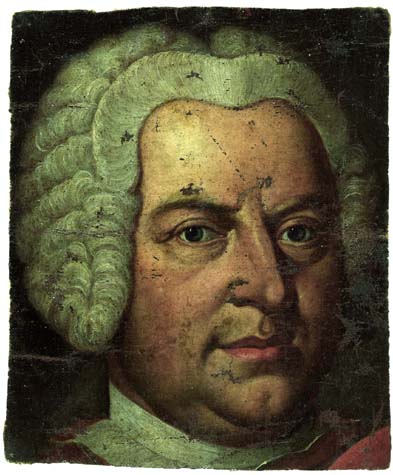

The Front and the Back of the Weydenhammer Portrait Fragment
Direct Digital Scans by Michael V. Cohen for New York Film Works
©Teri Noel Towe, 2001
The measurements of the Weydenhammer Portrait Fragment are:
Midline vertical: 282mm
Midline horizontal: 231mm
The portrait fragment, which has been cut out of what must once have been a significantly larger canvas, is not exactly "square".
The top horizontal measurement is 231mm, the bottom horizontal measurement is 235mm, the left vertical measurement is 276 mm,
and the right vertical measurement is 282 mm.
As is evident from the photograph of the back of the painting, the canvas is very old.
Fortunately, the portrait fragment, which has suffered some paint loss as well as abrasion and indentation to its surface and which is
in some places spotted with what appears to be a light brown grime, has never been restored, although there is one small patch of
"in painting" on the right cheek.
On January 9th of this year, I took the Weydenhammer Portrait Fragment up to Alain Goldrach's conservation studio on East 84th
Street here in New York so that Alain could examine it and offer an opinion on it. Alain Goldrach, who unfortunately could not join
us here today, is one of the top conservators and restorers of old master painting (in fact, of all types of oil paintings) in the United
States, if not the entire world, and his knowledge and expertise are unsurpassed. The star pupil and protegé of the renowned British
conservator of Old Master Paintings, John Brealey, Alain was a member of the conservation department at the Metropolitan
Museum of Art and then headed the Conservation Department at the Boston Museum of Fine Arts before he established his own
independent studio in NYC several years ago. The day that I went to see him, a Canaletto was on one easel, and a Van Dyck on
another.
Alain examined the painting with great care, and, at the outset, he observed that he could tell from the condition of the canvass that
the portrait head had been cut out of the top part of the original canvass, very close to where the original, larger canvass had been
folded over and attached to the top of the original stretcher. He was able to determine this by examining the back of the canvass.
In volunteering this information, without knowing it, Alain confirmed that there is nothing about the canvass that is inconsistent with
my belief about what its original dimensions were, and I shall return to Alain's observations on this point later on.
Alain also has confirmed that the canvass is of the right age and that there was nothing about either the front or the back of the
canvass or its condition that is inconsistent with fixing the date for the painting at around 1730 to 1735. I asked him about the
underlying, dark red ground that can be seen on the canvass in some of the spots where there has been paint loss. This ground,
which is called the bolus (Evidently, in using the expression "gesso" to describe this standard "priming coat" for an oil painting, I
had long been using a technically incorrect term.), is often precisely this shade because it is made from red clay. Alain said that this
kind of ground is what he would have expected to see beneath the painted surface of the canvass.
Alain carefully examined the surface of the painting, and he told me that, apart from the one tiny passage on Bach's right cheek that
I had suspected might have been retouched, there has been no restoration or overpainting done to the canvass. He also told me that
the possible birthmarks that I had wondered about on the upper right lip are at the very top of the surface of the canvass and are not
paint but blobs of varnish.
I asked him about the chin dimple. He told me that the combination of tiny blobs of varnish and some tiny bits of paint loss make
the dimple appear bigger than it actually is, but he also said that there is paint there as well, and therefore a smaller dimple.
I asked if it would serve any purpose to examine the painting under "black light". Alain said that it would confirm the conclusions
that he had drawn from his initial visual examinations and perhaps refine them. Our subsequent black light examination confirmed
the presence of the one bit of overpaint on the cheek, and, because a thick deposit of varnish looks greenish under black light,
confirmed that the possible birthmarks above the right lip are deposits of varnish, and not paint.
Alain said that, despite the loss of paint over the years, the painting is in good condition and that the paint is stable. I could not help
but recall Ernst Ludwig Gerber's words. Not once, but twice, he commented on the excellent condition of the painting that
belonged to Kittel. In 1812, he wrote of, "ein wohlgetroffenes Oelgemälde von Joh[ann] Sebast[ian] Bach" and, in 1814, he
described it as, "in Oel gemalt und sehr wohl erhalten."
Without my prompting him to express an opinion, Alain told me that, despite what it has been through, the painting is in a
remarkable state of preservation, and he also commented that it is very well painted. He said that it is the handiwork of an artist of
quality, but, because of his relative lack of familiarity with the portrait painters active in Germany at the time, he is unwilling to make
any suggestions as to who the artist might have been. He did, however, recommend that the painting be removed from the
cardboard backing to which it had been attached, for two reasons. First, the cardboard to which it was mounted is not acid free.
Second, the type of tape with which it had been attached to the cardboard was not good for the long term health of the painting.
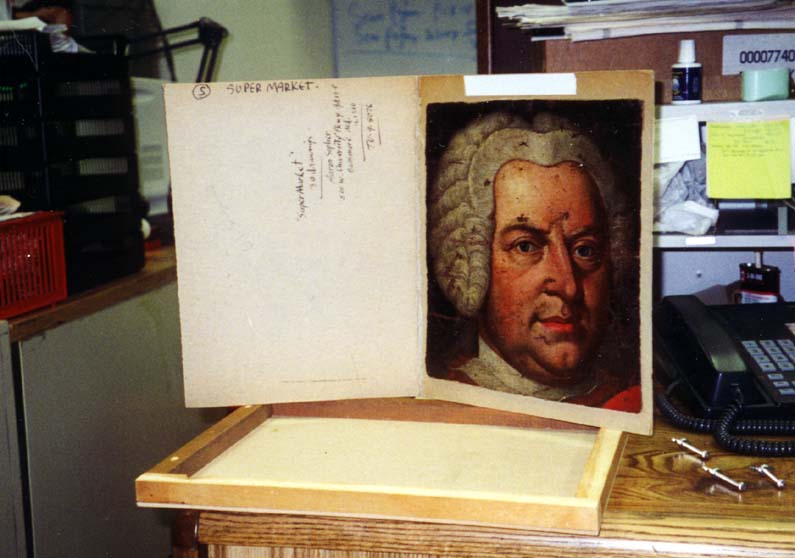
You surely will have noted the use of the past tense with respect to the cardboard and the tape. After securing permission from the
Weydenhammer Descendants, I took the Weydenhammer Portrait Fragment back to Alain's studio several days later. He detached
the painting from the cardboard and removed the tape. While Alain was removing the painting from the cardboard, I took a few
photos of the process.



Please click on 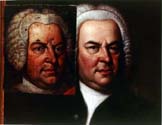 to advance to Page 11.
to advance to Page 11.
Please click on  to return to the Index Page at The Face Of Bach.
to return to the Index Page at The Face Of Bach.
Please click on  to visit the Johann Sebastian Bach Index Page at Teri Noel Towe's Homepages.
to visit the Johann Sebastian Bach Index Page at Teri Noel Towe's Homepages.
Please click on the 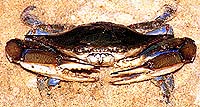 to visit the Teri Noel Towe Welcome Page.
to visit the Teri Noel Towe Welcome Page.
TheFaceOfBach@aol.com
Copyright, Teri Noel Towe, 2000 , 2002
Unless otherwise credited, all images of the Weydenhammer Portrait: Copyright, The Weydenhammer Descendants, 2000
All Rights Reserved
The Face Of Bach is a PPP Free Early Music website.

The Face Of Bach has received the HIP Woolly Mammoth Stamp of Approval from The HIP-ocrisy Home Page.